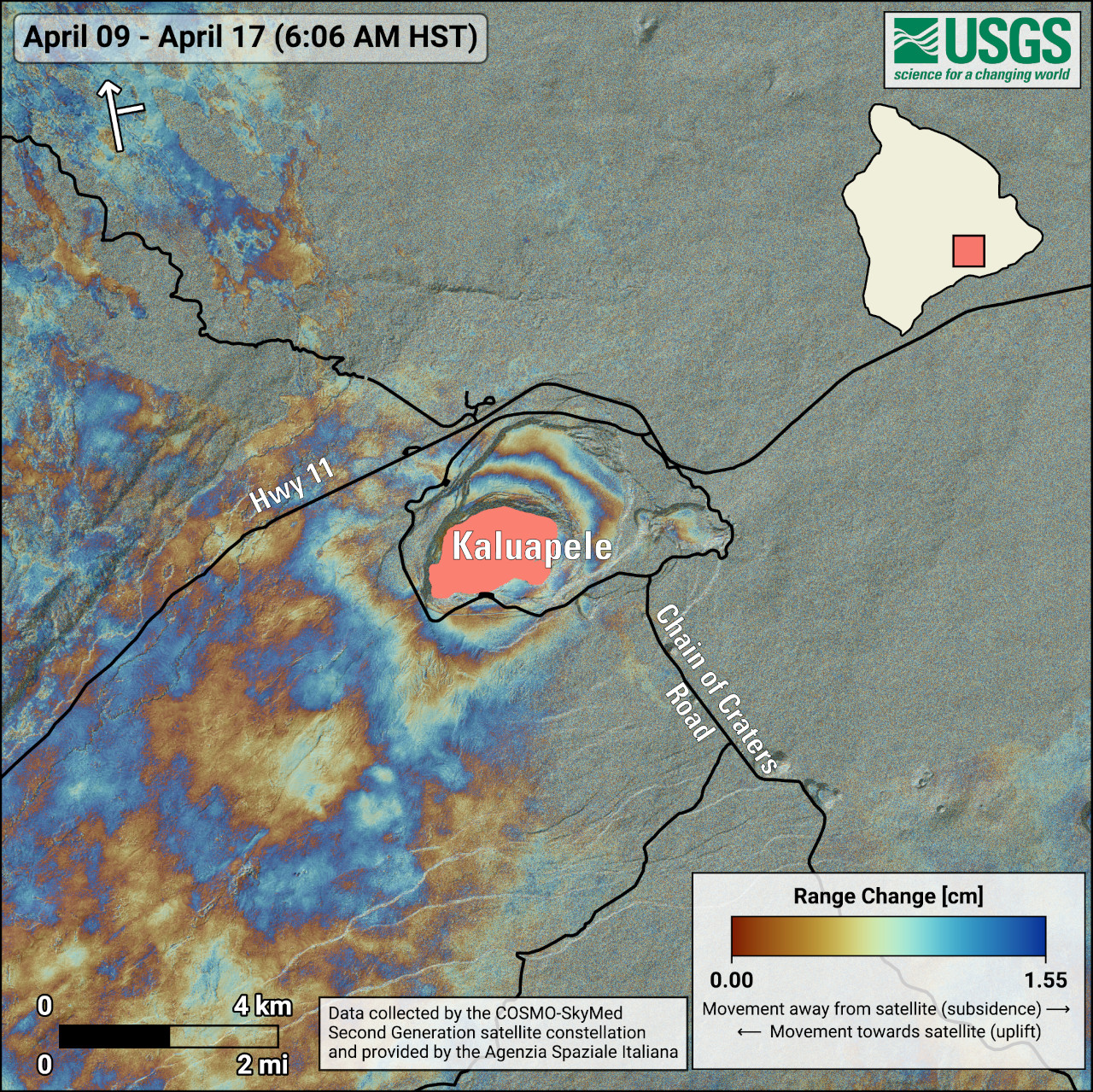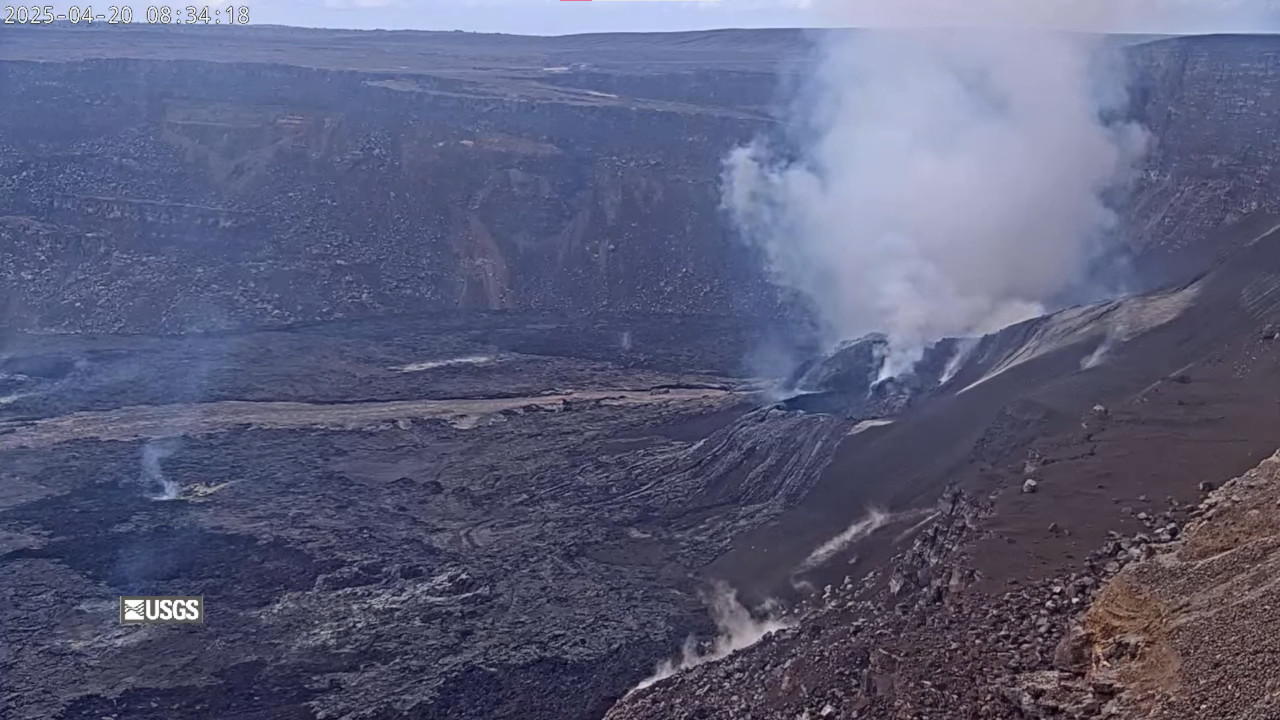(BIVN) – Episode 18 in the ongoing Kīlauea summit eruption restarted at 7:45 a.m. on Sunday morning, with small fountains feeding a lava flow from the south vent within Halemaʻumaʻu crater.
The USGS Hawaiian Volcano Observatory wrote in a short morning update that low fountains of 10 to 20 feet were an indication that “stronger fountains could begin at any time”.
“Tilt has leveled off, but is not yet deflating as typically coincides with the onset of high fountaining events from previous episodes,” the USGS HVO wrote in a later update.
From the USGS HVO daily update posted at 9:15 a.m. HST:
Summit Observations:
Glow was observed from the south and north vents most of last night, but no spattering was observed. At approximately 7:45 a.m. HST, episode 18 resumed with a narrow lava flow from the south vent. The south vent has a lava fountain that is 6-10 foot (2-3 meter) high and is feeding a lava flow that has reached approximately a third of the way across the crater floor (about 0.5 mile or about 1 kilometer). Strong degassing is currently occurring from both vents.
This episode was preceded by low level activity began around 9:10 p.m. HST on April 16, with bursts of spatter every 10-20 seconds from the north vent, reaching up to a few meters (several feet) high. Spatter bursts continued to increase in size and frequency until about 9:30 p.m. HST when 10-15 foot high (3-5 meters high) dome fountains began. Lava overflowed from the north vent around 10:01 p.m. HST and fed a small lava flow that reached about 100 meters (a few hundred feet) from the vent. This activity ended abruptly at 11:21 p.m. HST.
The UWD and SDH tiltmeters had shown an inflationary signal that had been persistent since the end of episode 17. As of this morning, UWD has measured approximately 16.5 microradians of inflationary tilt since 9:45 a.m. HST April 9; equaling the inflation at the start of episode 16. Tilt has since leveled off with the start of the south vent fountaining and lava flow. High fountains as observed from previous episodes are expected when a strong deflationary signal is detected.
Volcanic gas emissions remain elevated and at heightened levels due to lava fountaining. The last sulfur dioxide (SO2) emission rate measured on April 10 was approximately 1,200 tonnes per day. Typical levels of Sulfur dioxide (SO2) emission have been about 1,000 tonnes per day during previous pauses. Sulfur dioxide (SO2) emission rates during earlier fountaining episodes have reached 50,000 tonnes per day. This morning, the plume is being carried towards the south to southwest.
Strands of volcanic glass known as Pele’s hair from previous episodes are still present throughout the summit area of Hawaiʻi Volcanoes National Park and surrounding communities and can be remobilized by wind.

USGS: “This map shows deformation at Kīlauea volcano associated with the ongoing summit eruption that started on December 23, 2024. The image covers the timespan from April 9–17, 2025, using data recorded by the Italian Space Agency’s (ASI) COSMO-SkyMed Second Generation satellite constellation. Colored fringes denote areas of ground deformation, with more fringes indicating more deformation. Each color cycle represents 1.5 centimeters (0.6 inches) of range change. The symbol in the upper left indicates the satellite’s orbit direction (arrow) and look direction (bar). The round fringes within and around Kaluapele (Kīlauea summit caldera) indicate ground surface inflation over this time period (during the pause between episodes 17 and 18) as magma accumulates in the Halemaʻumaʻu magma chamber at a depth of approximately 1.5 kilometers (1 mile) below the ground surface.”
Rift Zone Observations:
Rates of seismicity and ground deformation remain very low in the East Rift Zone and Southwest Rift Zone with no significant earthquake activity in the past 24 hours. Sulfur dioxide (SO2) emissions from the East Rift Zone remain below detection limit.
Analysis:
The current eruption has been characterized by episodic fountaining not seen in any of the other Halemaʻumaʻu eruptions since 2020. Fountains and lava flows have erupted from two vents that we refer to as the north vent and south vent. Each of the previous 17 fountaining episodes lasted from a few hours to over a week and have been accompanied by strong deflation of the summit region. Pauses between the fountaining episodes have been marked by an immediate change from deflation to inflation as the magma chamber recharges and repressurizes.
Analysis of inflationary tilt patterns prior to the onset of each fountaining episode allows a time window of probability for the onset of new episodes to be estimated. These are calculated using both minimum inflation necessary to start a new eruption and the rate of inflation fit to data derived from past eruptive episodes. The precursory activity of episode 18 occurred as forecast on Wednesday April 16 when inflation slightly exceed episode 17, but was followed by continued inflation. The extended time gap between the precursory eruptive activity starting episode 18 and the onset of fountaining differs from the other episodes. This may be related to the early onset of episode 17. Inflation continued until today April 20, when it reached levels seen during episode 16. Eruption of degassed lava from the vent began at 7:45 a.m. HST and is continuing. Based upon prior cycles of fountaining and deflation, episode 18 fountaining is likely to be less than 24 hours long.
Lava stopped erupting from the south vent at 9:35 a.m., and then restarted at 9:43 a.m., feeding a new flow onto the crater floor.



by Big Island Video News10:13 am
on at
STORY SUMMARY
HAWAIʻI VOLCANOES NATIONAL PARK - Lava flows were observed at the summit on Sunday, as the Episode 18 began a start and stop pattern of eruptive activity.